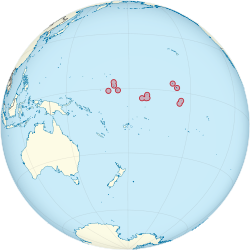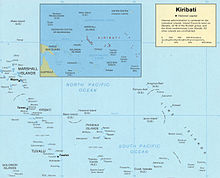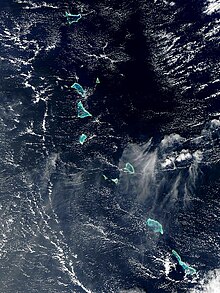Geography of Kiribati
1°25′N173°00′E/ 1.417°N 173.000°E
 | |
| Region | Oceania |
|---|---|
| Coordinates | 1°25′N173°00′E/ 1.417°N 173.000°E |
| Area | Ranked 172nd |
| • Total | 811 km2(313 sq mi) |
| • Land | .1% |
| • Water | 99.9% |
| Coastline | 1,143 km (710 mi) |
| Borders | None |
| Highest point | Unnamed location onBanaba 81 m (266 ft)[1] |
| Lowest point | Sea Level, 0 m (0 ft) |
| Climate | Maritime |
| Terrain | Atolls |
| Natural resources | Guano,fish, coconuts, petroleum |
| Natural hazards | Cyclones, |
| Environmental issues | rising sea levels |
| Exclusive economic zone | 3,441,810 km2(1,328,890 sq mi) |
Kiribaticonsists of 32atollsand one island in an expanse of ocean equivalent in size to thecontiguous United States.The islands are scattered such that Kiribati has territory located in each of the four hemispheres. The islands of Kiribati lie roughly halfway betweenHawaiiandAustraliain theMicronesianandPolynesianregions of the SouthPacific.The three main island groupings are theGilbert Islands,Phoenix Islands,andLine Islands.On 1 January 1995 Kiribati moved theInternational Date Lineto include its easternmost islands and make it the same day throughout the country.
Geography[edit]
Kiribati includesKiritimati(Christmas Atoll; in the Line Islands), the largest coral atoll (in terms of land area, not dimensions) in the world, andBanaba(Ocean Island), one of the three great phosphate rock islands in the Pacific.
Kiribati straddles the equator in the Pacific Ocean, about one-half of the way from Hawaii to Australia. On 1 January 1995, Kiribati unilaterally moved the International Date Line from the middle of the country to include its easternmost islands and make it the same day throughout the country.
Area[edit]


The total land area mass total 811 km2(313 sq mi). It includes three island groups -Gilbert Islands,Line Islands,Phoenix Islands.Most of the land on these islands is less than two metres above sea level.[2]Including the amount of water, the total water and land area is 2485 square miles. A 1989United Nationsreport identified Kiribati as one of the countries that could completely disappear in the 21st century if steps are not taken to address global climate change.
The coastline of the islands total 1,143 km (710 mi) in length. Kiribati has the 12th largestexclusive economic zoneof 3,441,810 km2(1,328,890 sq mi) (200 nautical miles). The islands are relatively flat and very spread out. The highest point, onBanaba Island,is 265 feet above sea level.
Climate[edit]
Due to its location, Kiribati exhibits a maritime climate. Temperatures range between 26 and 32 °C year-round, with the water temperature sitting on a comfortable year-round 28-29 °C. The dry season is from December to March while the wet season last from February to May and from September to November. In the driest years, the islands have received 150mm of rainfall while its wettest years have seen upwards of 4000mm.[3][4][5]
| Climate data forTarawa(Köppen Af) | |||||||||||||
|---|---|---|---|---|---|---|---|---|---|---|---|---|---|
| Month | Jan | Feb | Mar | Apr | May | Jun | Jul | Aug | Sep | Oct | Nov | Dec | Year |
| Record high °C (°F) | 35.0 (95.0) |
33.0 (91.4) |
35.0 (95.0) |
34.5 (94.1) |
34.5 (94.1) |
33.5 (92.3) |
34.5 (94.1) |
34.5 (94.1) |
34.5 (94.1) |
35.0 (95.0) |
35.0 (95.0) |
35.0 (95.0) |
35.0 (95.0) |
| Mean daily maximum °C (°F) | 30.7 (87.3) |
30.6 (87.1) |
30.7 (87.3) |
30.7 (87.3) |
30.8 (87.4) |
30.8 (87.4) |
30.9 (87.6) |
31.0 (87.8) |
31.1 (88.0) |
31.2 (88.2) |
31.3 (88.3) |
30.9 (87.6) |
30.9 (87.6) |
| Daily mean °C (°F) | 28.2 (82.8) |
28.1 (82.6) |
28.1 (82.6) |
28.2 (82.8) |
28.4 (83.1) |
28.3 (82.9) |
28.2 (82.8) |
28.3 (82.9) |
28.4 (83.1) |
28.6 (83.5) |
28.5 (83.3) |
28.2 (82.8) |
28.3 (82.9) |
| Mean daily minimum °C (°F) | 25.3 (77.5) |
25.3 (77.5) |
25.2 (77.4) |
25.3 (77.5) |
25.5 (77.9) |
25.3 (77.5) |
25.1 (77.2) |
25.2 (77.4) |
25.3 (77.5) |
25.4 (77.7) |
25.4 (77.7) |
25.3 (77.5) |
25.3 (77.5) |
| Record low °C (°F) | 21.5 (70.7) |
22.5 (72.5) |
22.5 (72.5) |
22.5 (72.5) |
21.0 (69.8) |
21.0 (69.8) |
21.0 (69.8) |
21.5 (70.7) |
22.5 (72.5) |
22.0 (71.6) |
22.5 (72.5) |
22.0 (71.6) |
21.0 (69.8) |
| Averageprecipitationmm (inches) | 271 (10.7) |
218 (8.6) |
204 (8.0) |
184 (7.2) |
158 (6.2) |
155 (6.1) |
168 (6.6) |
138 (5.4) |
120 (4.7) |
110 (4.3) |
115 (4.5) |
212 (8.3) |
2,052 (80.8) |
| Average precipitation days(≥ 0.3 mm) | 15 | 12 | 14 | 15 | 15 | 14 | 16 | 18 | 15 | 11 | 10 | 17 | 172 |
| Averagerelative humidity(%) | 81 | 80 | 81 | 82 | 81 | 81 | 80 | 79 | 77 | 77 | 79 | 81 | 80 |
| Mean monthlysunshine hours | 220.1 | 192.1 | 207.7 | 201.0 | 229.4 | 219.0 | 229.4 | 257.3 | 243.0 | 260.4 | 240.0 | 189.1 | 2,688.5 |
| Mean dailysunshine hours | 7.1 | 6.8 | 6.7 | 6.7 | 7.4 | 7.3 | 7.4 | 8.3 | 8.1 | 8.4 | 8.0 | 6.1 | 7.4 |
| Source:Deutscher Wetterdienst[6] | |||||||||||||
| Climate data forKiritimati(Köppen BSh) | |||||||||||||
|---|---|---|---|---|---|---|---|---|---|---|---|---|---|
| Month | Jan | Feb | Mar | Apr | May | Jun | Jul | Aug | Sep | Oct | Nov | Dec | Year |
| Record high °C (°F) | 32 (89) |
33 (91) |
33 (92) |
33 (92) |
34 (93) |
32 (90) |
32 (90) |
33 (91) |
33 (91) |
33 (92) |
33 (92) |
33 (91) |
34 (93) |
| Mean daily maximum °C (°F) | 29 (85) |
29 (85) |
30 (86) |
30 (86) |
31 (87) |
31 (87) |
30 (86) |
31 (87) |
31 (87) |
31 (87) |
30 (86) |
30 (86) |
30 (86) |
| Daily mean °C (°F) | 27 (80) |
27 (80) |
27 (81) |
27 (81) |
27 (81) |
27 (81) |
27 (81) |
28 (82) |
27 (81) |
27 (81) |
27 (81) |
27 (80) |
27 (81) |
| Mean daily minimum °C (°F) | 24 (75) |
24 (75) |
24 (76) |
24 (76) |
24 (76) |
24 (76) |
24 (76) |
25 (77) |
24 (76) |
24 (75) |
24 (76) |
24 (75) |
24 (76) |
| Record low °C (°F) | 19 (66) |
22 (71) |
22 (71) |
21 (70) |
23 (73) |
20 (68) |
22 (72) |
22 (71) |
21 (69) |
20 (68) |
19 (67) |
21 (69) |
19 (66) |
| Averageprecipitationmm (inches) | 25 (1.0) |
71 (2.8) |
64 (2.5) |
210 (8.1) |
89 (3.5) |
81 (3.2) |
51 (2.0) |
15 (0.6) |
2.5 (0.1) |
2.5 (0.1) |
7.6 (0.3) |
15 (0.6) |
633.6 (24.8) |
| Average precipitation days | 2.4 | 4.6 | 6.0 | 13.8 | 6.8 | 6.1 | 3.0 | 1.8 | 0.1 | 0.3 | 0.7 | 1.7 | 47.3 |
| Averagerelative humidity(%) | 77 | 80 | 80 | 83 | 81 | 80 | 78 | 75 | 74 | 74 | 73 | 75 | 78 |
| Source: Weatherbase[7] | |||||||||||||
Land use[edit]
The amount of arable land is at 2.5%. Crop usage stands at about 40% of the available land. A few trees exist and occupy 10% of the land. About 50% of the land is used for housing and commercial use.
Natural environment[edit]
Ecoregions[edit]
Kiribati is part of threeterrestrial ecoregions:[8]
- the Line Islands are in theCentral Polynesian tropical moist forestsecoregion
- the Phoenix Islands are in theWestern Polynesian tropical moist forestsecoregion
- the Gilbert islands and Banaba are in theEastern Micronesia tropical moist forestsecoregion
Natural resources[edit]
Much of the natural resources have been exhausted before its1979 independence.On the island of Banaba, the British minedguanofor phosphorus, until exhaustion of supply, an event that was before independence.[9]
Natural hazards[edit]
Cyclonescan occur any time, but usually November to March; occasionaltornadoes;low level of some of the islands make them very sensitive to changes in sea level. The Climate Change in the Pacific Report (2011) describes Kiribati as having a low risk of cyclones;[10]however in March 2015 Kiribati experienced flooding and destruction of seawalls and coastal infrastructure as the result ofCyclone Pam,a Category 5 cyclone that devastatedVanuatu.[11]
Pollution[edit]
The island of Banaba has suffered greatly from the after effects of the massive phosphorus mining. Most of the population were forced to evacuate to the island country ofFijidue to its effects. In addition, the atoll near the island of Tarawa is vulnerable to the effects of solid waste disposal. A report by the United Nations say the wildlife from the region are endangered. The islands are very sensitive to the damaging effects.[12]
International conventions[edit]
The country signed the Convention on Diversity on 6 August 1994.[13]
It also signed conventions on theClimate Change-Kyoto Protocol,Desertification,Hazardous Wastes,Law of the Sea,Marine Dumping, Ozone Layer Protection.[14]
Protected area[edit]

ThePhoenix Islands Protected Areaconstitutes 11.34% of Kiribati'sExclusive Economic Zone(EEZ) with a size of 408,250 km2(157,630 sq mi). This is thesecond largestmarine protected area(MPA) in thePacific Ocean.
Additional notes[edit]
21 of the 33 islands are inhabited.
Banaba (Ocean Island)in Kiribati is one of the three great phosphate rock islands in the Pacific Ocean.
Kiribati is the only country in the world whose land exists in all four hemispheres.[14]
Extreme points[edit]
This is a list of the extreme points ofKiribati,the points that are farther north, south, east or west than any other location.
- Northernmost point –Teraina(Washington Island),Line Islands
- Easternmost point –Caroline Island,Line Islands
- Southernmost point –Flint Island,Line Islands
- Westernmost point -Banaba Island
References[edit]
- ^"19. Banaba"(PDF).Office of Te Beretitent - Republic of Kiribati Island Report Series.2012. Archived fromthe original(PDF)on 23 September 2015.Retrieved28 April2015.
- ^Dekker, Rodney (9 December 2011)."Island neighbours at the mercy of rising tides".Australian Broadcasting Corporation.Retrieved9 December2011.
- ^"What Is the Climate of Kiribati?".traveltips.usatoday.com.Retrieved23 May2016.
- ^"Climate of the World: Kiribati - Weather UK - weatheronline.co.uk".weatheronline.co.uk.Retrieved23 May2016.
- ^"Current climate | Climate Change".climate.gov.ki.Archived fromthe originalon 11 March 2021.Retrieved23 May2016.
- ^ "Klimatafel von Tarawa, Int. Flugh. Bonriki / Kiribati (Gilbert-Inseln)"(PDF).Baseline climate means (1961–1990) from stations all over the world(in German). Deutscher Wetterdienst.Retrieved30 November2020.
- ^"Weatherbase: Historical Weather for London, Kiribati".Weatherbase. 2011.Archivedfrom the original on 11 June 2016.Retrieved14 May2016. Retrieved on 24 November 2011.
- ^Olson, D. M, E. Dinerstein; et al. (2001)."Terrestrial Ecoregions of the World: A New Map of Life on Earth".BioScience.51(11): 933–938.doi:10.1641/0006-3568(2001)051[0933:TEOTWA]2.0.CO;2.
{{cite journal}}:CS1 maint: multiple names: authors list (link) - ^"Banaba | island, Kiribati".Encyclopædia Britannica.Retrieved23 May2016.
- ^"Ch.6 Kiribati".Climate Change in the Pacific: Volume 2: Country Reports.Australia Government: Pacific Climate Change Science Program. 2011.
- ^"Flooding in Vanuatu, Kiribati and Tuvalu as Cyclone Pam strengthens".SBS Australia.13 March 2015.Retrieved15 March2015.
- ^"Environment - Kiribati - area".nationsencyclopedia.com.Retrieved23 May2016.
- ^"KIRIBATI NATIONAL ASSESSMENT REPORT"(PDF).Sustainable Development.United Nations.Retrieved23 May2016.
- ^ab"Australia - Oceania:: Kiribati – The World Factbook - Central Intelligence Agency".cia.gov.Retrieved5 April2019.
![]() This article incorporatespublic domain materialfromThe World Factbook.CIA.
This article incorporatespublic domain materialfromThe World Factbook.CIA.
